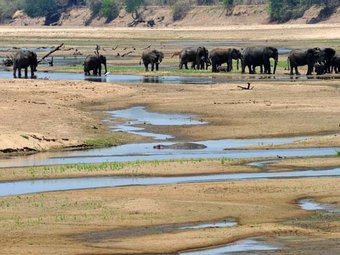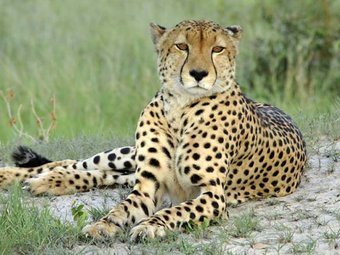Best of Kruger and Mpumalanga
8 days—South Africa: Best of Kruger and Mpumalanga
$4325-5220 USD
pp
Safari summary
MPUMALANGA - 'THE PLACE WHERE THE SUN RISES!' is considered to be one of the most geographically diverse and unbelievably beautiful places in South Africa.
Mpumalanga lies in the east of South Africa, north of KwaZulu-Natal and bordering Swaziland and Mozambique. In the northeast, the land rises towards mountain peaks and then terminates in an immense escarpment. In some places, this escarpment plunges hundreds of metres down to the low-lying area known as the Lowveld.
People are drawn to Mpumalanga by the magnificent scenery, by the fauna and flora and by the saga of the 1870s gold rush era and a wealth of fascinating tribal legends. Mountains, panoramic passes, valleys, rivers, waterfalls and forests characterise the landscape.
Kruger National Park.
Where nearly 2 million hectares of unrivalled diversity of life forms fuses with historical and archaeological sites - this is real Africa. The world-renowned Kruger National Park offers a wildlife experience that ranks with the best in Africa. Established in 1898 to protect the wildlife of the South African Lowveld, the Kruger National Park is unrivalled in the diversity of its life forms . Truly the flagship of the South African national parks, Kruger is home to an impressive number of species: 336 trees, 49 fish, 34 amphibians, 114 reptiles, 507 birds and 147 mammals. Man's interaction with the Lowveld environment over many centuries - from bushman rock paintings to majestic archaeological sites like Masorini and Thulamela - is evident in the Kruger National Park. These treasures represent the cultures, persons and events that played a role in the history of the Kruger National Park and are conserved along with the park's natural assets.
About this tour
| Tour type | Custom, tailor-made, private | |
| Main focus | Game drives | |
| Activity level | Easy activity | |
| Best months | All months | |
| Countries | ||
| Parks |
Itinerary
Day 1
Day 1: Johannesburg You are collected at O R Tambo airport and we drive to our guest house in the northern suburbs of Johannesburg, set in a secure golf estate, and check in. Johannesburg is an extraordinary city, born just over 125 years ago, when one of the world’s richest gold-bearing reefs was discovered under the sweeping savannah plains. The area of Johannesburg began on a vast undulating grassy plain, interspersed with ridges and kopjes (small hills) in an area known as the Witwatersrand, named after the white water springs that coursed the land. It wasn’t until George Harrison, an Australian prospector, arrived here that the mineral wealth of the Witwatersrand became apparent. In 1886, after George sold his gold claim for just £10, Johannesburg was born. He may never have envisaged the significant world history that would unfold here in the province of Gauteng, place of gold. Guest house in Johannesburg. We have optional excursions that we can offer you to do or we can relax in the garden or swim in the pool at the guest house in Johannesburg. Guest house 1 night; (D) South African Braai
Day 2
Kruger
Day 2 & 3: Sabi & Blyde River Today we start our safari after a scrumptious breakfast and travel from Johannesburg to Mpumalanga. We stop over at Dullstroom. The village, situated at 2100m above sea level in the Steenkampsberg range, dates back to the early 1880's, when Dutch settlers came to the area. The town derives its name from one Wolterus Dull, chairman of the Dutch immigrants. The "stroom" (stream) refers to the abundance of water in the area: The Crocodile River, which runs through the Kruger National Park, has its origin in Dullstroom. Beautiful Pilgrim’s Rest. In the afternoon we visit Pilgrim’s Rest. Mining in this region of Mpumalanga dates back many centuries, when unknown miners worked quartz reefs in the area for gold. Proof of these diggings can still be found in this area. The history of this small delightful village dates back to 1873 when a miner, Alex Patterson, discovered alluvial gold on the farm named Ponieskrantz. He had left the Mac- Mac area to search for a place that was less congested. Though the discovery was kept as a secret, the inevitable happened when a second prospector, William Trafford, also discovered gold close by. What they had found in this beautiful valley, drew optimistic gold panners and prospectors from all over the country and the world (news of gold strikes of this magnitude travel fast!). On 22nd September 1873 Pilgrim's Rest was officially proclaimed a gold field and the scatter of tents and rudimentary shacks soon grew into a flourishing little village complete with sturdy brick houses, church, shops, canteens, a newspaper and the well-known Royal Hotel. The diggers called it Pilgrim's Rest because here, at last, after so many false trails and faded dreams, they had truly found their home. In due course the alluvial deposits were depleted and the locals turned to forestry. This village, whose residents still number in the hundreds, has been painstakingly preserved as a "living museum" and is a major South African tourist venue. On our second day we visit the scenic sights of Blyde River Canyon including the Potholes and Three Rondavels. In the afternoon we visit the Lone Creek Waterfall. Along the edge of the escarpment, we visit God’s Window (time and weather permitting) and the scenic gorge with the Pinnacle Rock. The entire Mpumalanga area offers exceptional opportunities for bird- watching, hiking, horse-riding and fishing. Streams once panned for gold have become the haunts of eager anglers and lazy trout. Steeped in the history of pioneers, hunters and fortune seekers, fascinating gold rush towns abound. Mpumalanga offers something for everyone. We overnight in the Sabi area. Lodge; 2 nights (2 x B, 2 x D)
Day 4
Kruger
Days 4-6: Kruger National Park After breakfast we continue our safari to the Kruger National Park. African Hunting Dog. The first explorer to set foot in the region was the Dutchman François de Cuiper who led a Dutch East India Company expedition to explore the region. However, the expedition was attacked and driven back by local tribes-people near Gomondwane. Only around 1838 were Voortrekker expeditions led by Louis Trichardt and Hans van Rensburg able to successfully establish forward outposts. Hundreds of Europeans and farmers came to the Lowveld lured by rumors of gold and the great quantity of valuable commodities such as ivory and skins. This caused the number of game to dramatically decrease due to hunting and trading of animal skins and horns. President Paul Kruger was told about the rapid destruction of wildlife in the area by hunters, after which he succeeded to persuade the Transvaal parliament to establish a protected area for wildlife in the Lowveld region. Elephant in Kruger National Park. The very first ranger in the reserve was Paul Bester who made his residence in a rustic rondavel (hut) which is now the site of the headquarters camp, Skukuza. Documents concerning the History of the Kruger National Park can be viewed at the Skukuza Library. We do a morning game drive to our camp and settle into our chalet. Looming several hundred feet over the Olifants river bushveld is this eponymous hilltop rest camp, which provides an authentic experience of this area's rugged wildlife, varied flora and exquisite panoramic view. Park officials warn that certain creatures which inhabit the park could prove dangerous if not approached or handled correctly. These may include bats, spiders, snakes, and scorpions. In the afternoon we do a game drive to learn more of the fauna and flora before returning to our camp and sundowners under the African skies. Black Rhino Kruger Park. All the remaining days in the park we go on morning and afternoon game drives exploring different areas of the park. The Kruger National Park is the second-largest game reserve in Africa and the largest in South Africa. Keeping in theme with the name of the camp, the area plays host to a multitude of elephants. Baboons, vervet monkeys, fruit bats and thick-tailed bush babies all reside in the Olifants area, as well as lion, leopard and Cape Clawless otter. Situated in rugged veld on rhyolite and basalt soil, Olifants river rest hosts lowveld cluster-leaf, raisin bush and mopane. The camp itself exhibits an abundance of trees and plants, including a variety of aloe species. Probably the only accessible sesame bush in the Kruger National Park can also be seen here, as well as sjambok pod (yellow flowers), weeping boerboon (red flowers) and tree euphorbia can all be sighted in the area depending on season. Zebra Kruger Park.
Day 7
Day 7: Johannesburg After breakfast we do a game drive out of the park on our way to Johannesburg. We should arrive in Johannesburg the late afternoon. Guest House: 1 night (1xB)
Day 8
Day 8: To the Airport Transfer to the airport for your return flight home. End of our service.
Here are the latest tours by Barefoot Safaris.
Zambia: Luangwa National Park
Tour by: Barefoot Safaris
Countries:

Focus: Game drives
Zambia and Botswana
Tour by: Barefoot Safaris
Countries:


Focus: Walking safari—with armed guard
Cleanliness of vehicle
Meet and greet team
Quality of itinerary
Responsiveness of staff



